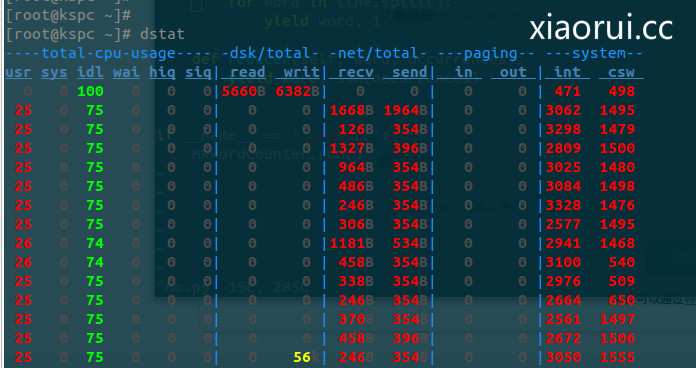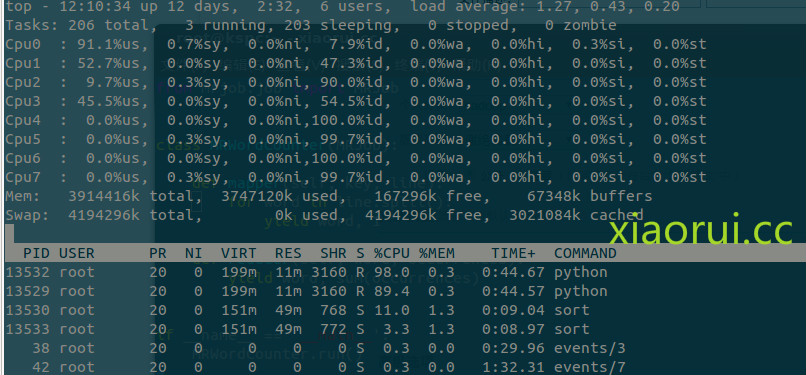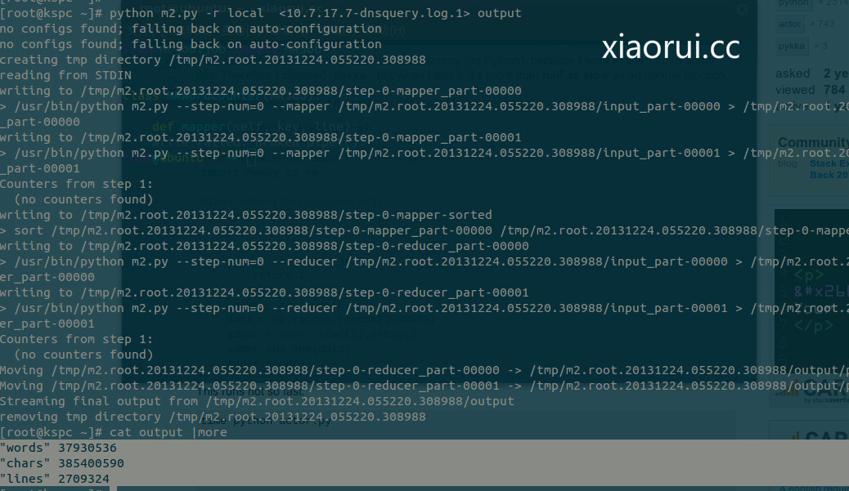python调用mrjob实现hadoo
发布时间:2019-09-17 07:47:30编辑:auto阅读(2567)
使用纯 Python 编写多步的 MapReduce 作业
在本机上进行测试
在 Hadoop 集群上运行
咱们一般写mapreduce是通过java和streaming来写的,身为pythoner的我,
java不会,没办法就用streaming来写mapreduce日志分析。 这里要介绍一个
模块,是基于streaming搞的东西。
mrjob 可以让用 Python 来编写 MapReduce 运算,并在多个不同平台上运行,你可以:
pip 的安装方法:
pip install mrjob
我测试的脚本
#coding:utf-8
from mrjob.job import MRJob
import re
#xiaorui.cc
#WORD_RE = re.compile(r"[\w']+")
WORD_RE = re.compile(r"\d{1,3}\.\d{1,3}\.\d{1,3}\.\d{1,3}")
class MRWordFreqCount(MRJob):
def mapper(self, word, line):
for word in WORD_RE.findall(line):
yield word.lower(), 1
def combiner(self, word, counts):
yield word, sum(counts)
def reducer(self, word, counts):
yield word, sum(counts)
if __name__ == '__main__':
MRWordFreqCount.run()用法算简单:
python i.py -r inline input1 input2 input3 > out 命令可以将处理多个文件的结果输出到out文件里面。
本地模拟hadoop运行:python 1.py -r local <input> output
这个会把结果输出到output里面,这个output必须写。
hadoop集群上运行:python 1.py -r hadoop <input> output
执行脚本 ~
[root@kspc ~]# python mo.py -r local <10.7.17.7-dnsquery.log.1> output no configs found; falling back on auto-configuration no configs found; falling back on auto-configuration creating tmp directory /tmp/mo.root.20131224.040935.241241 reading from STDIN writing to /tmp/mo.root.20131224.040935.241241/step-0-mapper_part-00000 > /usr/bin/python mo.py --step-num=0 --mapper /tmp/mo.root.20131224.040935.241241/input_part-00000 | sort | /usr/bin/python mo.py --step-num=0 --combiner > /tmp/mo.root.20131224.040935.241241/step-0-mapper_part-00000 writing to /tmp/mo.root.20131224.040935.241241/step-0-mapper_part-00001 > /usr/bin/python mo.py --step-num=0 --mapper /tmp/mo.root.20131224.040935.241241/input_part-00001 | sort | /usr/bin/python mo.py --step-num=0 --combiner > /tmp/mo.root.20131224.040935.241241/step-0-mapper_part-00001 Counters from step 1: (no counters found) writing to /tmp/mo.root.20131224.040935.241241/step-0-mapper-sorted > sort /tmp/mo.root.20131224.040935.241241/step-0-mapper_part-00000 /tmp/mo.root.20131224.040935.241241/step-0-mapper_part-00001 writing to /tmp/mo.root.20131224.040935.241241/step-0-reducer_part-00000 > /usr/bin/python mo.py --step-num=0 --reducer /tmp/mo.root.20131224.040935.241241/input_part-00000 > /tmp/mo.root.20131224.040935.241241/step-0-reducer_part-00000 writing to /tmp/mo.root.20131224.040935.241241/step-0-reducer_part-00001 > /usr/bin/python mo.py --step-num=0 --reducer /tmp/mo.root.20131224.040935.241241/input_part-00001 > /tmp/mo.root.20131224.040935.241241/step-0-reducer_part-00001 Counters from step 1: (no counters found) Moving /tmp/mo.root.20131224.040935.241241/step-0-reducer_part-00000 -> /tmp/mo.root.20131224.040935.241241/output/part-00000 Moving /tmp/mo.root.20131224.040935.241241/step-0-reducer_part-00001 -> /tmp/mo.root.20131224.040935.241241/output/part-00001 Streaming final output from /tmp/mo.root.20131224.040935.241241/output removing tmp directory /tmp/mo.root.20131224.040935.241241
执行的时候,资源的占用情况。
发现一个很奇妙的东西,mrjob居然调用shell下的sort来排序。。。。
为了更好的理解mrjob的用法,再来个例子。
from mrjob.job import MRJob #from xiaorui.cc class MRWordFrequencyCount(MRJob): #把东西拼凑起来 def mapper(self, _, line): yield "chars", len(line) yield "words", len(line.split()) yield "lines", 1 #总结kv def reducer(self, key, values): yield key, sum(values) if __name__ == '__main__': MRWordFrequencyCount.run()
看下结果:
下面是官网给的一些个用法:
我们可以看到他是支持hdfs和s3存储的 !
Running your job different ways
The most basic way to run your job is on the command line:
$ python my_job.py input.txt
By default, output will be written to stdout.
You can pass input via stdin, but be aware that mrjob will just dump it to a file first:
$ python my_job.py < input.txt
You can pass multiple input files, mixed with stdin (using the - character):
$ python my_job.py input1.txt input2.txt - < input3.txt
By default, mrjob will run your job in a single Python process. This provides the friendliest debugging experience, but it’s not exactly distributed computing!
You change the way the job is run with the -r/--runner option. You can use -rinline (the default), -rlocal, -rhadoop, or -remr.
To run your job in multiple subprocesses with a few Hadoop features simulated, use -rlocal.
To run it on your Hadoop cluster, use -rhadoop.
If you have Elastic MapReduce configured (see Elastic MapReduce Quickstart), you can run it there with -remr.
Your input files can come from HDFS if you’re using Hadoop, or S3 if you’re using EMR:
$ python my_job.py -r emr s3://my-inputs/input.txt $ python my_job.py -r hadoop hdfs://my_home/input.txt
上一篇: aliyun域名解析python api
下一篇: Codewarrior 中的 .prm
- openvpn linux客户端使用
51745
- H3C基本命令大全
51426
- openvpn windows客户端使用
41838
- H3C IRF原理及 配置
38606
- Python exit()函数
33104
- openvpn mac客户端使用
30096
- python全系列官方中文文档
28765
- python 获取网卡实时流量
23763
- 1.常用turtle功能函数
23676
- python 获取Linux和Windows硬件信息
22044
- Ubuntu本地部署dots.ocr
72°
- Python搭建一个RAG系统(分片/检索/召回/重排序/生成)
2271°
- Browser-use:智能浏览器自动化(Web-Agent)
2965°
- 使用 LangChain 实现本地 Agent
2469°
- 使用 LangChain 构建本地 RAG 应用
2415°
- 使用LLaMA-Factory微调大模型的function calling能力
3012°
- 复现一个简单Agent系统
2423°
- LLaMA Factory-Lora微调实现声控语音多轮问答对话-1
3227°
- LLaMA Factory微调后的模型合并导出和部署-4
5320°
- LLaMA Factory微调模型的各种参数怎么设置-3
5142°
- 姓名:Run
- 职业:谜
- 邮箱:383697894@qq.com
- 定位:上海 · 松江



